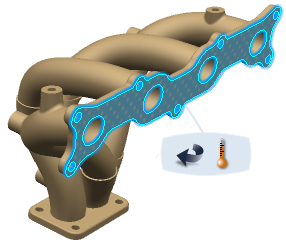About Temperatures | ||||
|
| |||
Click Play to watch the video:
A temperature definition consists of two components:
- the constrained surface (defined by the selected part face); and
- a specified magnitude.
The constrained surface remains at the specified temperature throughout the simulation, regardless of the heat flowing through the rest of the model.
A constant temperature generally represents a surface that is connected to another large component or immersed in a steady temperature field. The surface shares the temperature of the attached component or field, and temperature fluctuations in other areas of the part are not siginificant enough to affect the connecting interface.
For example, if a portion of your part is submerged in a large pool of cold water at a constant temperature, the submerged surfaces will likely remain at the temperature of the water; any heat that flows near these surfaces is quickly dissipated into the water with insignificant effect on the overall temperature. Similarly, a manifold connected to a hot engine will maintain a constantly high temperature in the vicinity of the engine despite attempts to cool other areas of the manifold.